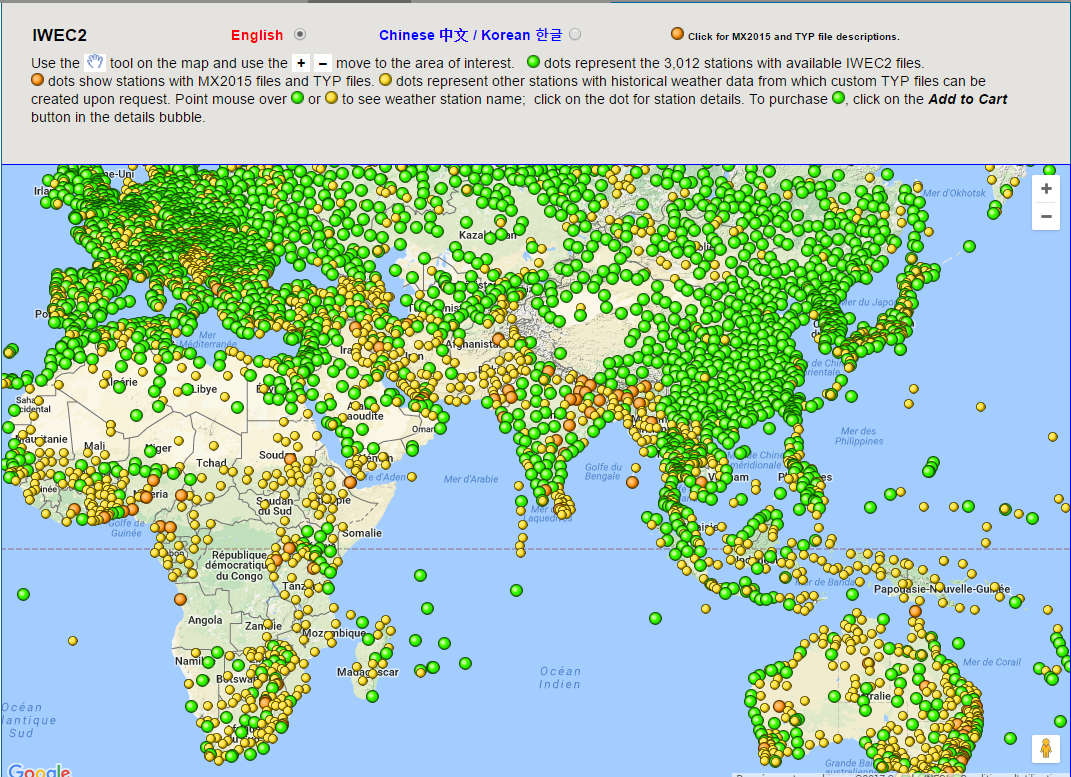ASHRAE IWEC2 data
ASHRAE IWEC2 (http://ashrae.whiteboxtechnologies.com/home{:target="blank"}) is a set of TMY weather files for _3012 ground stations outside of the US and Canada. They were developed through ASHRAE Research Project RP-1477 - "Development of 3012 Typical Year Weather Files for International Locations" (*) - for the need of energy building simulation. The data covers the 1999-2011 period at minimum, which represents 12 years of records. Some files extend up to 1986-2011 (25 years). Irradiances are not measured but derived from 2 models.
Data covers useful information for PVsyst:
- Global horizontal irradiance (derived from model)
- Diffuse horizontal irradiance (derived from model)
- Wind speed
- Temperature
The data is available for pay.
Details of the Method
(partially from here)
For the need of energy building simulation, ASHRAE developed in 2001 the IWEC (International Weather for Energy Calculations) weather files for 227 non-North American locations (Thevenard and Brunger, 2001).
From 2007 through 2011, new available data was analysed on ASHRAE 1477-RP (original title "Development of 'Typical Year' Weather Files from the ISH Database of Historical Weather Data for 2500 International Locations") to produce IWEC2 (International Weather for Energy Calculations Version 2) weather files for 3012 international locations outside of the U.S. and Canada.
IWEC2 weather files are derived from mweather data reports of weather stations around the world that are archived in the Integrated Surface Hourly (ISH) data base maintained by the National Climatic Data Center (NCDC). For these selected locations, the ISH database contains weather observations on average at least four times per day of wind speed and direction, sky cover, visibility, ceiling height, dry-bulb temperature, dew-point temperature, atmospheric pressure, liquid precipitation, and present weather for at least 12 years of record up to 25 years.
Because the ISH database contains no measured solar radiation, the hourly total horizontal solar radiation is calculated using an empirical Zhang-Huang Model based on the sun-earth geometry, reported cloud cover, temperature difference from three hours previously, relative humidity, and wind speed, which is then adjusted on an hourly basis using the new ASHRAE Clear Sky Model to correct for statistical noise in the hourly profile. A second empirical Gompertz Function Model is used to calculate the direct normal solar radiation based on the solar angle and the ratio of the derived total global horizontal compared to the extraterrestrial solar radiation. Other models then use these derived solar radiation values to calculate various illuminances (global horizontal, direct normal, diffuse horizontal) and zenith luminance that are useful for daylighting studies.
(*) by White Box Technologies, Moraga, California, Y. Joe Huang, Principal Investigator
